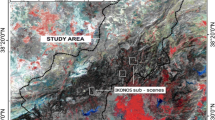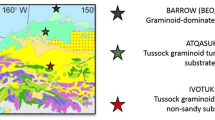Abstract
Emissions of methane (CH4), carbon dioxide (CO2), and nitrous oxide (N2O) from a forested watershed (160 ha) in South Carolina, USA, were estimated with a spatially explicit watershed-scale modeling framework that utilizes the spatial variations in physical and biogeochemical characteristics across watersheds. The target watershed (WS80) consisting of wetland (23%) and upland (77%) was divided into 675 grid cells, and each of the cells had unique combination of vegetation, hydrology, soil properties, and topography. Driven by local climate, topography, soil, and vegetation conditions, MIKE SHE was used to generate daily flows as well as water table depth for each grid cell across the watershed. Forest-DNDC was then run for each cell to calculate its biogeochemistry including daily fluxes of the three greenhouse gases (GHGs). The simulated daily average CH4, CO2 and N2O flux from the watershed were 17.9 mg C, 1.3 g C and 0.7 mg N m−2, respectively, during the period from 2003–2007. The average contributions of the wetlands to the CH4, CO2 and N2O emissions were about 95%, 20% and 18%, respectively. The spatial and temporal variation in the modeled CH4, CO2 and N2O fluxes were large, and closely related to hydrological conditions. To understand the impact of spatial heterogeneity in physical and biogeochemical characteristics of the target watershed on GHG emissions, we used Forest-DNDC in a coarse mode (field scale), in which the entire watershed was set as a single simulated unit, where all hydrological, biogeochemical, and biophysical conditions were considered uniform. The results from the field-scale model differed from those modeled with the watershed-scale model which considered the spatial differences in physical and biogeochemical characteristics of the catchment. This contrast demonstrates that the spatially averaged topographic or biophysical conditions which are inherent with field-scale simulations could mask “hot spots” or small source areas with inherently high GHGs flux rates. The spatial resolution in conjunction with coupled hydrological and biogeochemical models could play a crucial role in reducing uncertainty of modeled GHG emissions from wetland-involved watersheds.










Similar content being viewed by others
References
Abbott, M., Bathurst, J., Cunge, J., O’Connell, P., & Rasmussen, J. (1986a). An Introduction to the European Hydrological System—Systeme Hydrologique Europeen, “SHE”, 1: History and philosophy of a physically-based, distributed modelling system. J Hydrology, 87, 45–59.
Abbott, M., Bathurst, J., Cunge, J., O’Connell, P., & Rasmussen, J. (1986b). An Introduction to the European Hydrological System – Systeme Hydrologique Europeen, “SHE”, 2: Structure of a Physically-based, Distributed Modelling System. J Hydrology, 87, 61–77.
Amatya, D.M., Sun, G., Trettin, C.C. and Skaggs, R.W. (2003). Long-term Forest Hydrologic Monitoring in Coastal Carolinas. In Renard, Kenneth G., McElroy, Stephen A., Gburek, William J., Canfield, H. Evan and Scott, Russell L. (Eds.), Proc. of First Interagency Conference on Research in the Watersheds, U.S. Department of Agriculture, Agricultural Research Service, October 27–30, 2003, pp. 279–285.
Bréda, N. J. J. (2003). Ground-based measurements of leaf area index: a review of methods, instruments and current controversies. J. Exper. Botany, 54, 2403–2417.
Dai, Z., Li, C., Trettin, C. C., Sun, G., Amayta, D. M., & Li, H. (2010). Bi-criteria evaluation of MIKE SHE model for a forested watershed on South Carolina coastal plain. Hydrol. Earth Syst. Sci., 14, 1033–1046. doi:10.5194/hess-14-1033-2010.
DHI. (2005). MIKE SHE Technical Reference. Version 2005. DHI Water and Environment. Denmark: Danish Hydraulic Institute.
Graham, D. N., & Butts, M. B. (2005). Chapter 10 flexible integrated watershed modeling with MIKE SHE. In V. P. Singh & D. K. Frevert (Eds.), Watershed Models. Boca Raton: CRC Press.
Harder, S. V., Amatya, D. M., Callahan, T. J., Trettin, C. C., & Hakkila, J. (2007). Hydrology and water budget for a forested Atlantic Coastal Plain watershed, South Carolina. JAWRA, 43, 563–575.
Hook, D.D., Buford, M.A. and Williams, T.M. (1991). Impact of Hurricane Hugo on the South Carolina Coastal Plain Forest. Journal of Coastal Research (special issue no. 8), 291–300.
Huang, Y., Zhang, W., Zheng, X., Han, S., & Yu, Y. (2006). Estimates of methane emissions from Chinese rice paddies by linking a model to GIS database. Acta Ecologic Sinica, 26, 980–988.
Kesik, M., Brüggemann, N., Forkel, R., Kiese, R., Knoche, R., Li, C., et al. (2006). Future scenarios of N2O and NO emissions from European forest soils. JGR, 111, 2018–2022. doi:10.1029/2005JG000115.
Kiese, R., Li, C., Hilbert, D. W., Papen, H., & Butterbach-Bahl, K. (2005). Regional application of PnET-DNDC for estimating the N2O source strength of tropic rainforests in the Wet Tropics of Australia. Global Change Biology, 11, 128–144.
Kurbatova, J., Li, C., Varlagin, A., Xiao, X., & Vygodskaya, N. (2008). Modeling carbon dynamics in two adjacent spruce forests with different soil conditions in Russia. Biogeosciences, 5, 969–980.
Li, C., Frolking, S., & Frolking, T. A. (1992a). A model of nitrous oxide evolution from soil driven by rainfall events: Model structure and sensitivity. JGR, 97, 9759–9776.
Li, C., Frolking, S., & Frolking, T. A. (1992b). A model of nitrous oxide evolution from soil driven by rainfall events: Model application. JGR, 97, 9777–9783.
Li, C., Aber, J., Stang, F., Butter-Bahl, K., & Papen, H. (2000). A process-oriented model of N2O and NO emissions from forest soils. 1. Model development. JGR Atmos, 105, 4369–4384.
Li, C., Cui, J., Sun, G., & Trettin, C. C. (2004). Modeling impacts of management on carbon sequestration and trace gas emissions in forested wetland ecosystems. Environmental Management (Supplement), 33, S176–S186.
Lloyd, F. T., & Olson, D. F. (1974). The precision and repeatability of a leaf biomass sampling technique for mixed hardwood stands. Journal of Applied Ecology, 11, 1035–1042.
Long, B. M. (1980). Soil Survey of Berkeley County (p. 99). South Carolina: United States Department of Agriculture.
Lu, J., Sun, G., McNulty, S.G. and Comerford, N. (2011). Evaluation and application of the MIKE SHE model for a cypress-pine flatwoods watershed in North Central Florida. Wetlands (in press).
Mernild, S. H., Hasholt, B., & Liston, G. E. (2008). Climatic control on river discharge simulations, Zackenberg River drainage basin, northeast Greenland. Hydrological Processes, 22, 1932–1948.
Miehle, P., Livesley, S. J., Feikema, P. M., Li, C., & Arndt, S. K. (2006). Assessing productivity and carbon sequestration capability of Eucalyptus globulus plantations using the process model Forest-DNDC: Calibration and validation. Ecological Modelling, 192, 83–94.
Nash, J. E., & Sutcliffe, J. V. (1970). River flow forecasting through conceptual models—part I: a discussion of principles. J. Hydrology, 10, 282–290.
Pansu, M., Bottner, P., Sarmiento, L. and Metselaar, K. (2004). Comparison of five soil organic matter decomposition models using data from a 14C and 15N labeling field experiment. Global Biogeochemical Cycles 18, GB4022.
Pietsch, S. A., Hasenauer, H., Kucera, J., & Cermak, J. (2003). Modeling effects of hydrological changes on the carbon and nitrogen balance of oak in floodplains. Tree Phys., 23, 735–746.
Rask, H., Schoenau, J., & Anderson, D. (2002). Factors influencing methane flux from a boreal forest wetland in Saskatchewan, Canada. Soil Biology & Biogeochemistry, 34, 435–443.
Renaud, L. (2008). Methane emissions from bottomland hardwood wetlands in Francis Marion National Forest, SC. MS thesis, College of Charleston, Charleston, p. 112
Rose, C., & Crumpton, W. G. (2006). Spatial patterns in dissolved oxygen and methane concentrations in a Prairie Pothole wetland in Iowa, USA. Wetlands, 26, 1020–1025.
Sahoo, G. B., Ray, C., & Carlo, E. H. (2006). Calibration and validation of a physically distributed hydrological model, MIKE SHE, to predict discharge at high frequency in a flashy mountainous Hawaii stream. J. Hydrology, 327, 94–109.
Shindell, D. T., Walter, B. P., & Faluvegi, G. (2004). Impacts of climate change on methane emissions from wetlands. Geophysical Research Letters, 31, L21202. doi:10.1029/2004GL021009.
Smemo, K. A., & Yavitt, J. B. (2006). A Multi-year Perspective on Methane Cycling in a Shallow Peat Fen in Central New York State, USA. Wetlands, 26, 20–29.
Stang, F., Butterbach-Bahl, K., & Papen, H. (2000). A process-oriented model of N2O and NO emissions from forest soils. 2. Sensitivity analysis and validation. JGR, 105, 4385–4398.
Sun, G., Lu, J., Gartner, D., Miwa, M. and Trettin, C.C. (2000). Water budgets of two forested watersheds in South Carolina. In R.W. Higgins (Ed) Proceedings of the Spring Special Conference, American Water Resources Association, Miami, Florida, pp. 199-202
Sun, G., Li, C., Trettin, C., Lu, J. and McNulty, S.G. (2006). Simulating the biogeochemical cycles in cypress wetland-pine upland ecosystems at a landscape scale with the Wetland-DNDC model. In Proceedings of the International Conference on Hydrology and Management of Forested Wetlands, New Bern, NC, April 8–12, 2006, pp. 261–270.
Trettin, C. C., & Jurgensen, M. F. (2003). Carbon cycling in wetland forest soils. In J. Kimble, R. Birdsie, & R. Lal (Eds.), Carbon sequestration in US forests. Boca Raton: CRC Press.
Trettin, C. C., Laiho, R., Minkkinen, K., & Laine, J. (2006). Influence of climate change factors on carbon dynamics in northern forested peatlands. Can. J. Soil Sci., 86, 269–280.
Vázquez, R. F., Willems, P., & Feyen, J. (2008). Improving the predictions of a MIKE SHE catchment-scale application by using a multi-criteria approach. Hydrological Processes, 22, 2159–2179.
Wang, Y., Amundson, R., & Niu, X. F. (2000). Seasonal and altitudinal variation in decomposition of soil organic matter inferred from radiocarbon measurements of soil CO2 flux. Global Biogeochemical Cycles, 14, 199–211.
Xu, C.-Y., & Singh, V. P. (2005). Evaluation of three complementary relationship evapotranspiration models by water balance approach to estimate actual regional evapotranspiration in different climatic regions. Journal of Hydrology, 308, 105–121.
Zhang, Y., Li, C., Trettin, C. C., & Sun, G. (2002). An integrated model of soil, hydrology and vegetation for carbon dynamics in wetland ecosystems. Global Biogeochemical Cycles, 16, 1–17. doi:10.1029/2001GB001838.
Zhang, Z., Wang, S., Sun, G., McNulty, S. G., Zhang, H., Li, J., et al. (2008). Evaluation of the MIKE SHE model for application in the Loess Plateau, China. JAWRA, 44, 1108–1120.
Author information
Authors and Affiliations
Corresponding author
Rights and permissions
About this article
Cite this article
Dai, Z., Trettin, C.C., Li, C. et al. Effect of Assessment Scale on Spatial and Temporal Variations in CH4, CO2, and N2O Fluxes in a Forested Wetland. Water Air Soil Pollut 223, 253–265 (2012). https://doi.org/10.1007/s11270-011-0855-0
Received:
Accepted:
Published:
Issue Date:
DOI: https://doi.org/10.1007/s11270-011-0855-0




